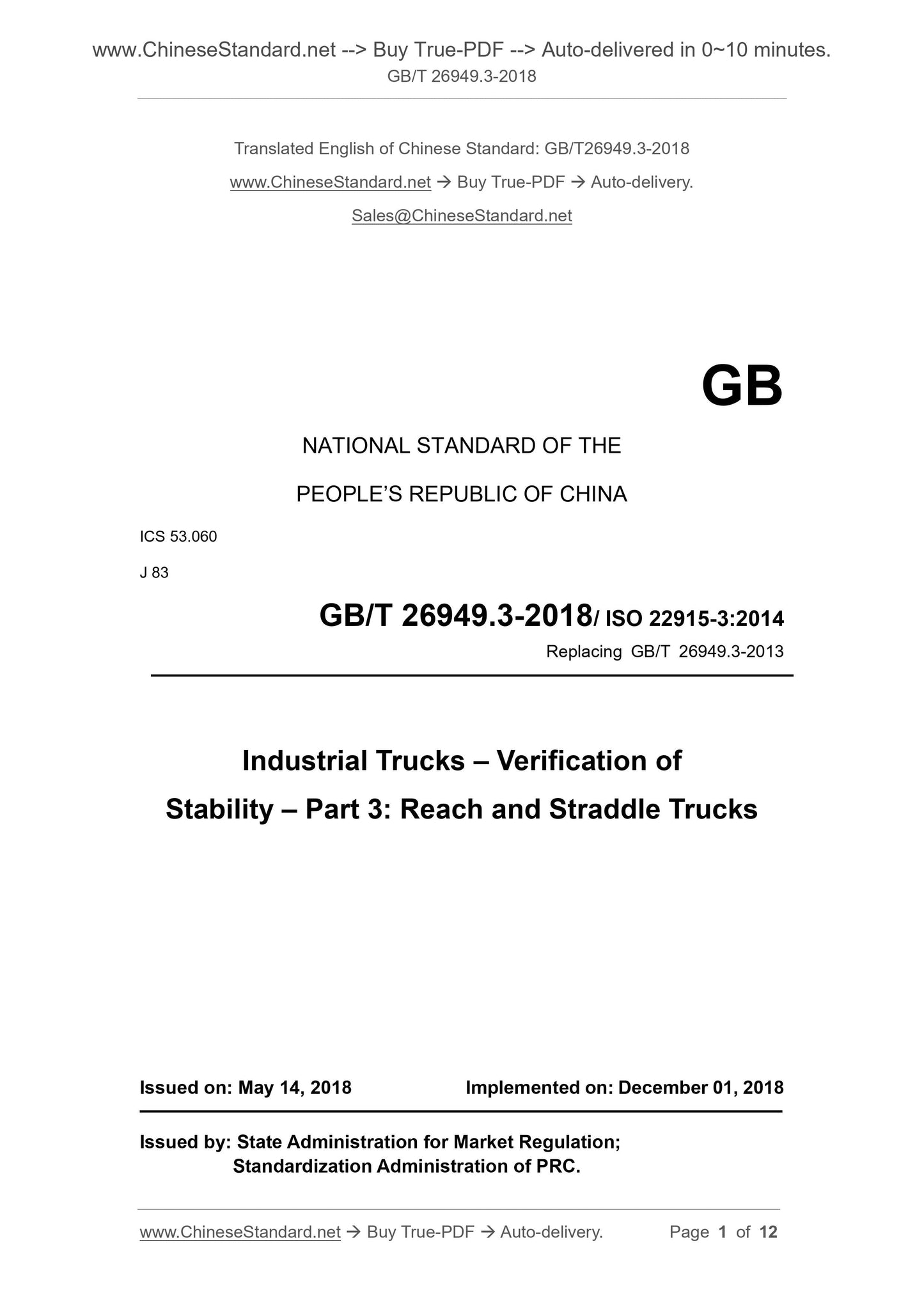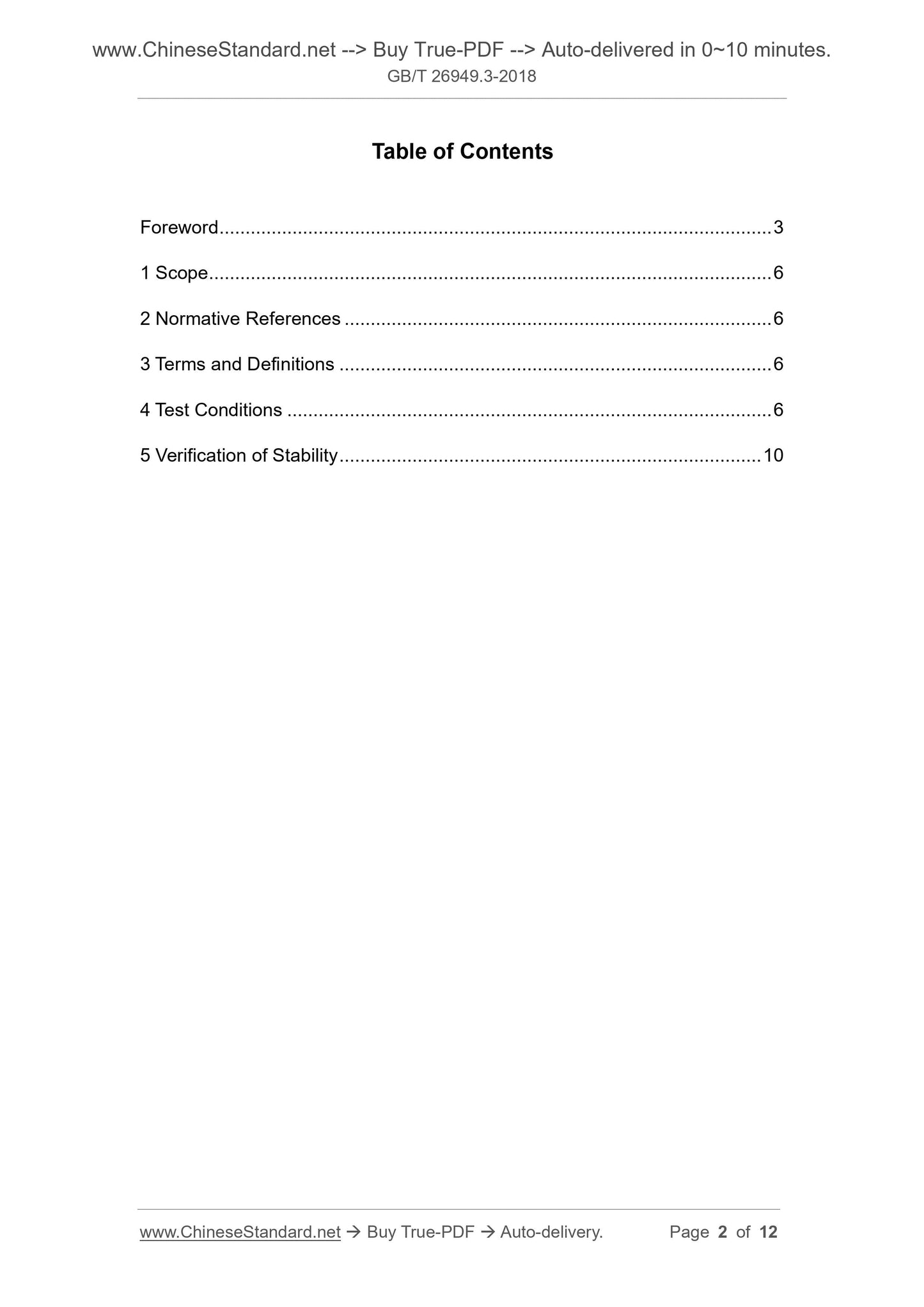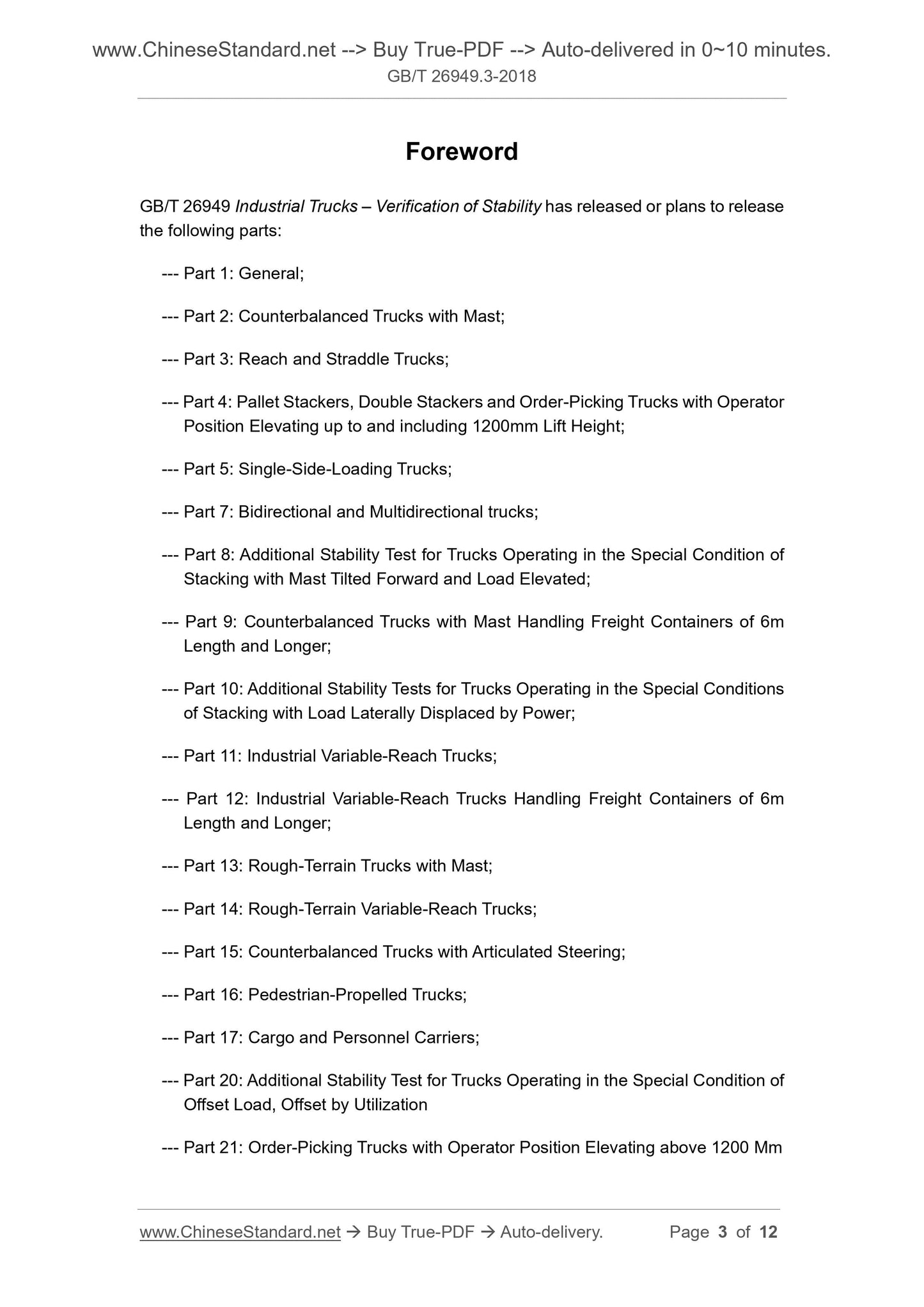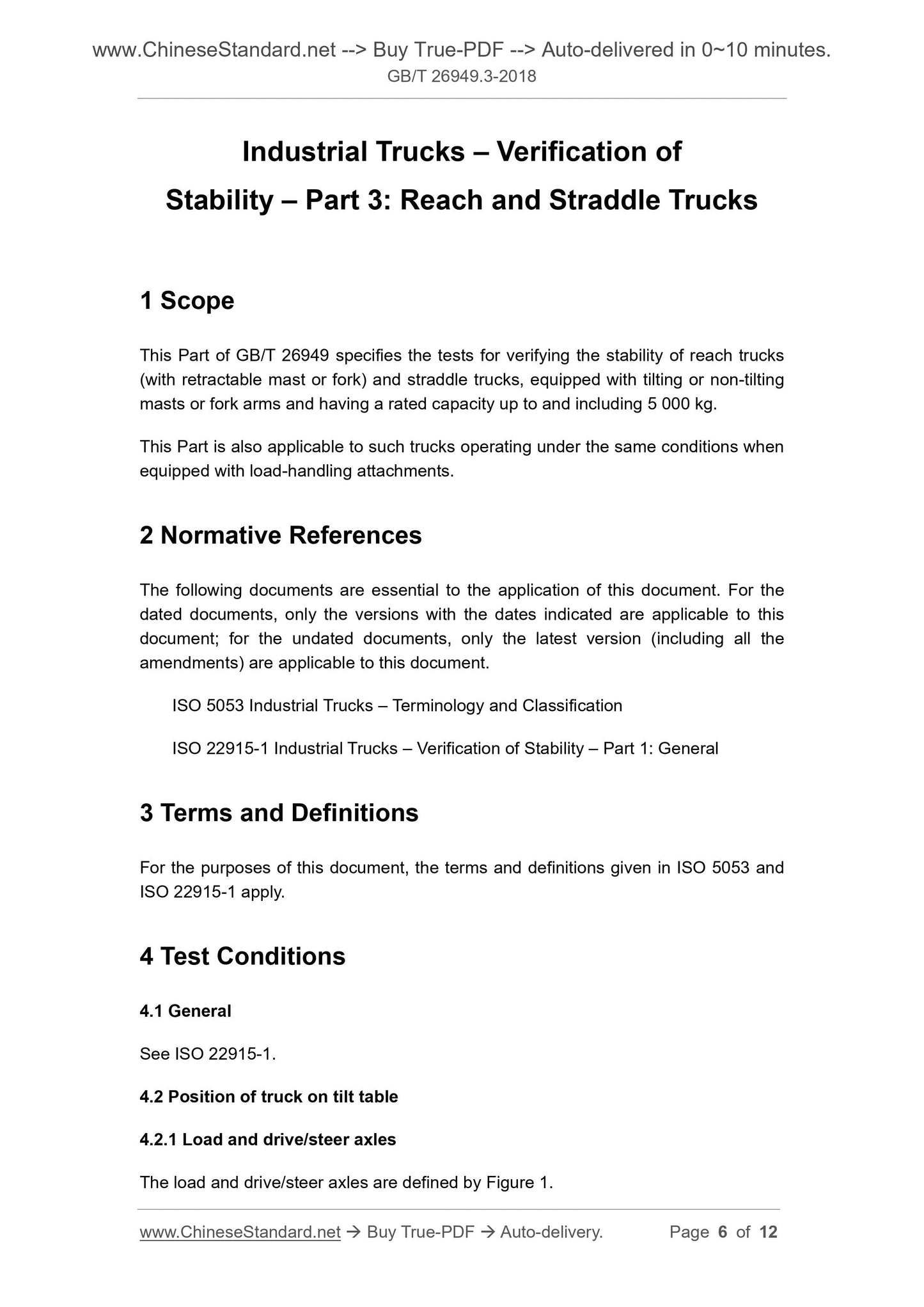1
/
of
4
PayPal, credit cards. Download editable-PDF and invoice in 1 second!
GB/T 26949.3-2018 English PDF (GBT26949.3-2018)
GB/T 26949.3-2018 English PDF (GBT26949.3-2018)
Regular price
$150.00 USD
Regular price
Sale price
$150.00 USD
Unit price
/
per
Shipping calculated at checkout.
Couldn't load pickup availability
Delivery: 3 seconds. Download true-PDF + Invoice.
Get QUOTATION in 1-minute: Click GB/T 26949.3-2018
Historical versions: GB/T 26949.3-2018
Preview True-PDF (Reload/Scroll if blank)
GB/T 26949.3-2018: Industrial trucks -- Verification of stability -- Part 3: Reach and straddle trucks
GB/T 26949.3-2018
Industrial trucks--Verification of stability--Part 3. Reach and straddle trucks
ICS 53.060
J83
National Standards of People's Republic of China
Replace GB/T 26949.3-2013
Industrial vehicle stability verification
Part 3. Forward and legged forklifts
Part 3. Reachandstraddletrucks
(ISO 22915-3..2014, IDT)
Published on.2018-05-14
2018-12-01 implementation
State market supervision and administration
China National Standardization Administration issued
Foreword
GB/T 26949 "Industrial Vehicle Stability Verification" has or plans to release the following parts.
--- Part 1. General;
---Part 2. Counterbalanced forklift;
--- Part 3. Forward and legged forklifts;
--- Part 4. Pallet stacker, double stacker and picker with a height of not more than 1200mm from the operator's position;
--- Part 5. Side forklifts (one side);
--- Part 7. Two-way and multi-directional operation of the forklift;
--- Part 8. Additional stability tests for stacking operations under gantry forward and load lift conditions;
---Part 9. Counterbalanced forklifts carrying freight containers of 6m and longer lengths;
--- Part 10. Additional stability tests for stacking operations under lateral load conditions of power units;
--- Part 11. Telescopic forklift;
--- Part 12. Telescopic forklifts carrying freight containers of 6m and longer lengths;
--- Part 13. Off-road forklifts with gantry;
--- Part 14. Off-road telescopic forklift;
--- Part 15. Counterbalanced forklifts with articulated steering;
--- Part 16. Walker vehicles;
--- Part 17. Cargo and personnel carriers;
--- Part 20. Additional stability tests for operation under load bias conditions;
--- Part 21. Picking vehicles with an operator position elevation greater than 1200 mm;
--- Part 22. Three-way stacker forklifts with or without operator position;
--- Part 24. Off-road rotary telescopic forklift.
This part is the third part of GB/T 26949.
This part is drafted in accordance with the rules given in GB/T 1.1-2009.
This part replaces GB/T 26949.3-2013 "Industrial Vehicle Stability Verification Part 3. Forward and Leg-mounted Forklifts".
Compared with GB/T 26949.3-2013, the main technical changes in this section are as follows.
--- Modified the description of all types of casters (see 4.2.3, 4.2.3 of the.2013 edition).
This section uses the translation method equivalent to ISO 22915-3.2014 "Industrial Vehicle Stability Verification Part 3. Forward and Legs
Forklift.
The documents of our country that have a consistent correspondence with the international documents referenced in this part are as follows.
--- GB/T 6104.1-2018 Industrial vehicle terms and classification - Part 1. Industrial vehicle type (ISO 5053-1.2015,
IDT)
--- GB/T 26949.1-2012 Industrial vehicle stability verification Part 1. General (ISO 22915-1.2008, IDT)
This part was proposed by the China Machinery Industry Federation.
This part is under the jurisdiction of the National Industrial Vehicle Standardization Technical Committee (SAC/TC332).
This section is responsible for drafting units. Hangcha Group Co., Ltd., Beijing Crane Transportation Machinery Design and Research Institute.
Participated in the drafting of this section. Anhui Heli Co., Ltd., Linde (China) Forklift Co., Ltd., Ningbo Ruyi Co., Ltd.
Nuoli Machinery Co., Ltd., Longhe Intelligent Equipment Manufacturing Co., Ltd., Zhengzhou Jiachen Electric Co., Ltd.
The main drafters of this section. Xie Guosheng, Wang Dan, Bao Jiannan, Wang Moyang, Ni Jingzhong, Li Yingxin, Ye Jianbo, Luo Jiafu, Yang Jing, Yao Xin.
The previous versions of the standards replaced by this section are.
---GB/T 5142-1985, GB/T 5142-2005;
---GB/T 26949.3-2013.
Industrial vehicle stability verification
Part 3. Forward and legged forklifts
1 Scope
This part of GB/T 26949 specifies verification of inclined or non-tilt gantry or fork, rated lifting capacity is not more than 5000kg
Test method for stability of reach trucks (with retractable gantry or fork) and leg-mounted forklifts.
This section also applies to forklift trucks of the same type with load handling attachments under the same operating conditions.
2 Normative references
The following documents are indispensable for the application of this document. For dated references, only dated versions apply to this article.
Pieces. For undated references, the latest edition (including all amendments) applies to this document.
ISO 5053 Industrial Vehicle Terms and Classifications (Industrialtrucks-Terminologyandclassification)
ISO 22915-1 - Determination of stability of industrial vehicles - Part 1. General (Industrialtrucks-Verificationofstabili-
ty-Part 1.General)
3 Terms and definitions
The terms and definitions defined by ISO 5053 and ISO 22915-1 apply to this document.
4 test conditions
4.1 General
See ISO 22915-1.
4.2 Position of the vehicle on the inclined platform
4.2.1 Load bridges and drive/steering axles
Figure 1 defines the load bridge and drive/steering axle of the vehicle.
4.2.2 Test 1, Test 2, Test 6, Test 7 and Test 8
The vehicle should be placed on a tilting platform whose drive/steering bridge BB and load bridge CC should be parallel to the tilt axis of the tilting platform
XY, see Table 1.
Description.
AA---the longitudinal center plane of the vehicle;
BB---drive/steering bridge;
CC---load bridge.
Figure 1 Load bridge and drive/steering axle
4.2.3 Test 3, Test 4 and Test 5
The vehicle should be placed on a tilting platform with the MN line parallel to the tilting axis XY of the tilting platform, see Table 1.
The definition of point M is as follows.
a) For vehicles with a single non-articulated drive (steering) wheel. M point is the drive (steering) wheel axle centerline and drive wheel width
The vertical projection of the intersection of the heart surface on the inclined platform.
b) For vehicles with rigidly supported casters.
1) When testing on the side of the caster of the vehicle, the M point is the center line of the caster axle and the center plane or double of the single caster wheel
The vertical projection of the intersection of the center faces between the two wheels of the caster on the inclined platform, while the rigidly supported caster axle
The center line should be close to the center plane of the vehicle;
2) When testing on the side of the drive (steering) wheel of the vehicle, point M is the drive (steering) wheel axle center line and drive wheel
The vertical projection of the intersection of the wide central plane on the inclined platform.
c) For vehicles where the drive/steering axle is articulated on the frame and the hinge point is in the center plane of the vehicle. point M is the transverse axis of the articulated frame
The vertical projection of the intersection of the line with the longitudinal center plane AA of the vehicle on the inclined platform.
d) For vehicles with a non-rigid support caster and a single rigidly supported drive (steering) wheel. M point is the drive wheel axle
The vertical projection of the intersection between the centerline and the wide center plane of the drive wheel on the inclined platform, while driving the wheel axis and the tilting axis
The line is vertical.
e) For vehicles with a non-hinged two-wheel drive (steering) unit mounted on a swivel base. the M point is the transaxle centerline and close to the tilt
The vertical projection of the intersection of the wide central plane of the drive wheel of the oblique axis on the inclined platform, while driving the wheel axle and the tilt axis
vertical. <...
Get QUOTATION in 1-minute: Click GB/T 26949.3-2018
Historical versions: GB/T 26949.3-2018
Preview True-PDF (Reload/Scroll if blank)
GB/T 26949.3-2018: Industrial trucks -- Verification of stability -- Part 3: Reach and straddle trucks
GB/T 26949.3-2018
Industrial trucks--Verification of stability--Part 3. Reach and straddle trucks
ICS 53.060
J83
National Standards of People's Republic of China
Replace GB/T 26949.3-2013
Industrial vehicle stability verification
Part 3. Forward and legged forklifts
Part 3. Reachandstraddletrucks
(ISO 22915-3..2014, IDT)
Published on.2018-05-14
2018-12-01 implementation
State market supervision and administration
China National Standardization Administration issued
Foreword
GB/T 26949 "Industrial Vehicle Stability Verification" has or plans to release the following parts.
--- Part 1. General;
---Part 2. Counterbalanced forklift;
--- Part 3. Forward and legged forklifts;
--- Part 4. Pallet stacker, double stacker and picker with a height of not more than 1200mm from the operator's position;
--- Part 5. Side forklifts (one side);
--- Part 7. Two-way and multi-directional operation of the forklift;
--- Part 8. Additional stability tests for stacking operations under gantry forward and load lift conditions;
---Part 9. Counterbalanced forklifts carrying freight containers of 6m and longer lengths;
--- Part 10. Additional stability tests for stacking operations under lateral load conditions of power units;
--- Part 11. Telescopic forklift;
--- Part 12. Telescopic forklifts carrying freight containers of 6m and longer lengths;
--- Part 13. Off-road forklifts with gantry;
--- Part 14. Off-road telescopic forklift;
--- Part 15. Counterbalanced forklifts with articulated steering;
--- Part 16. Walker vehicles;
--- Part 17. Cargo and personnel carriers;
--- Part 20. Additional stability tests for operation under load bias conditions;
--- Part 21. Picking vehicles with an operator position elevation greater than 1200 mm;
--- Part 22. Three-way stacker forklifts with or without operator position;
--- Part 24. Off-road rotary telescopic forklift.
This part is the third part of GB/T 26949.
This part is drafted in accordance with the rules given in GB/T 1.1-2009.
This part replaces GB/T 26949.3-2013 "Industrial Vehicle Stability Verification Part 3. Forward and Leg-mounted Forklifts".
Compared with GB/T 26949.3-2013, the main technical changes in this section are as follows.
--- Modified the description of all types of casters (see 4.2.3, 4.2.3 of the.2013 edition).
This section uses the translation method equivalent to ISO 22915-3.2014 "Industrial Vehicle Stability Verification Part 3. Forward and Legs
Forklift.
The documents of our country that have a consistent correspondence with the international documents referenced in this part are as follows.
--- GB/T 6104.1-2018 Industrial vehicle terms and classification - Part 1. Industrial vehicle type (ISO 5053-1.2015,
IDT)
--- GB/T 26949.1-2012 Industrial vehicle stability verification Part 1. General (ISO 22915-1.2008, IDT)
This part was proposed by the China Machinery Industry Federation.
This part is under the jurisdiction of the National Industrial Vehicle Standardization Technical Committee (SAC/TC332).
This section is responsible for drafting units. Hangcha Group Co., Ltd., Beijing Crane Transportation Machinery Design and Research Institute.
Participated in the drafting of this section. Anhui Heli Co., Ltd., Linde (China) Forklift Co., Ltd., Ningbo Ruyi Co., Ltd.
Nuoli Machinery Co., Ltd., Longhe Intelligent Equipment Manufacturing Co., Ltd., Zhengzhou Jiachen Electric Co., Ltd.
The main drafters of this section. Xie Guosheng, Wang Dan, Bao Jiannan, Wang Moyang, Ni Jingzhong, Li Yingxin, Ye Jianbo, Luo Jiafu, Yang Jing, Yao Xin.
The previous versions of the standards replaced by this section are.
---GB/T 5142-1985, GB/T 5142-2005;
---GB/T 26949.3-2013.
Industrial vehicle stability verification
Part 3. Forward and legged forklifts
1 Scope
This part of GB/T 26949 specifies verification of inclined or non-tilt gantry or fork, rated lifting capacity is not more than 5000kg
Test method for stability of reach trucks (with retractable gantry or fork) and leg-mounted forklifts.
This section also applies to forklift trucks of the same type with load handling attachments under the same operating conditions.
2 Normative references
The following documents are indispensable for the application of this document. For dated references, only dated versions apply to this article.
Pieces. For undated references, the latest edition (including all amendments) applies to this document.
ISO 5053 Industrial Vehicle Terms and Classifications (Industrialtrucks-Terminologyandclassification)
ISO 22915-1 - Determination of stability of industrial vehicles - Part 1. General (Industrialtrucks-Verificationofstabili-
ty-Part 1.General)
3 Terms and definitions
The terms and definitions defined by ISO 5053 and ISO 22915-1 apply to this document.
4 test conditions
4.1 General
See ISO 22915-1.
4.2 Position of the vehicle on the inclined platform
4.2.1 Load bridges and drive/steering axles
Figure 1 defines the load bridge and drive/steering axle of the vehicle.
4.2.2 Test 1, Test 2, Test 6, Test 7 and Test 8
The vehicle should be placed on a tilting platform whose drive/steering bridge BB and load bridge CC should be parallel to the tilt axis of the tilting platform
XY, see Table 1.
Description.
AA---the longitudinal center plane of the vehicle;
BB---drive/steering bridge;
CC---load bridge.
Figure 1 Load bridge and drive/steering axle
4.2.3 Test 3, Test 4 and Test 5
The vehicle should be placed on a tilting platform with the MN line parallel to the tilting axis XY of the tilting platform, see Table 1.
The definition of point M is as follows.
a) For vehicles with a single non-articulated drive (steering) wheel. M point is the drive (steering) wheel axle centerline and drive wheel width
The vertical projection of the intersection of the heart surface on the inclined platform.
b) For vehicles with rigidly supported casters.
1) When testing on the side of the caster of the vehicle, the M point is the center line of the caster axle and the center plane or double of the single caster wheel
The vertical projection of the intersection of the center faces between the two wheels of the caster on the inclined platform, while the rigidly supported caster axle
The center line should be close to the center plane of the vehicle;
2) When testing on the side of the drive (steering) wheel of the vehicle, point M is the drive (steering) wheel axle center line and drive wheel
The vertical projection of the intersection of the wide central plane on the inclined platform.
c) For vehicles where the drive/steering axle is articulated on the frame and the hinge point is in the center plane of the vehicle. point M is the transverse axis of the articulated frame
The vertical projection of the intersection of the line with the longitudinal center plane AA of the vehicle on the inclined platform.
d) For vehicles with a non-rigid support caster and a single rigidly supported drive (steering) wheel. M point is the drive wheel axle
The vertical projection of the intersection between the centerline and the wide center plane of the drive wheel on the inclined platform, while driving the wheel axis and the tilting axis
The line is vertical.
e) For vehicles with a non-hinged two-wheel drive (steering) unit mounted on a swivel base. the M point is the transaxle centerline and close to the tilt
The vertical projection of the intersection of the wide central plane of the drive wheel of the oblique axis on the inclined platform, while driving the wheel axle and the tilt axis
vertical. <...
Share








